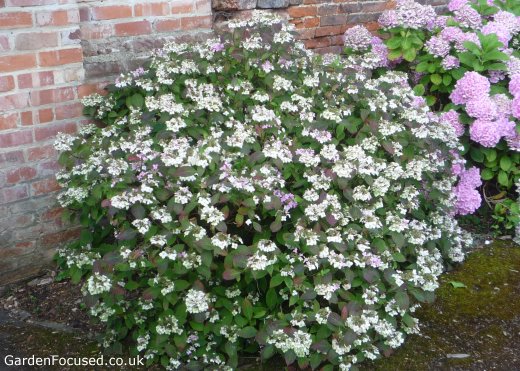APPEARANCE
Hydrangea serrata ‘Bluebird’ will grow to a height and spread of 1m / 39in after three or four years. The slightly fleshy mid green leaves cover the entire plant giving is an evenly rounded appearance. The leaves turn to a reddy brown in autumn.
Colour of the flowers is variable depending on the the acidity (blue flowers) or alkalinity (pink) of the soil, both colours are very attractive. Flowers are produced from late June to early September
‘Bluebird’, when planted in the open, is frost hardy down to -10C so issuitable for almost all parts of the UK. Occasionally a late a hard frost candamage the buds which will result in less flowers that year but it will recoverthe next year.
If you are growing ‘Bluebird’ in a container we would recommend moving it a protected position (maybe out of the wind against a house wall) for the winter.
CARE OF HYDRANGEA SERRATA VARIETIES
Hydrangea serrata is classified as an individual species, however to all intents and purposes it is just a slightly smaller growing Hydrangea macrophyllaand should be cared for in the same manner.
Plant them in a position which is moist and in part shade. Ideally, sun inthe morning and late afternoon but shady during the hottest part of the day.
Feed them in spring and autumn with a long lasting fertiliser such as fish, blood and bone. Do not feed them with a normal high nitrogen plant food, this will simply encourage foliage growth at the expense of flowers.
During their first year of growth, water them in dry periods. In subsequent years, water them in extended drought. Container grown plants will require much more frequent watering to keep the soil moist.
Hydrangea serrata benefit from a mulch (compost, leaf mould etc.) in each spring about 5cm / 2in deep around the plant. Grass clippings can also be used but apply them in spring and mid summer.
All organic mulches will retain moisture and provide a low level of nutrients as the mulch breaks down.
Pruning is easy. Leave the dead flower heads on the plant until March or April time. At that stage, remove the blooms and trim the stems back to just above the highest (or second highest) set of healthy buds. Flowers appear on the previous year’s growth.
Take a look around the shrub (especially the middle of it) and cut back to ground level any damaged or diseased stems.
It is quite possible to rejuvenate an old and congested Hydrangea serrata ‘Bluebird by cutting the entire shrub to just above ground level in March. It will take another year before it produces flowers again.
WHERE TO BUY HYDRANGEA SERRATA ‘BLUEBIRD
Hydrangea paniculata ‘Limelight’ is a very common shrub and should be available in very many garden centres.It is also readily available online.From past experience we would recommend Crocus if you want buy this shrub online, see their
page here.
SUMMARY OF HYDRANGEA SERRATA ‘BLUEBIRD’
HEIGHT: 1m (3ft 3in)
SPREAD: 1m (3ft 3in)
FLOWER COLOUR: Blue in acidic soil to pink in alkaline soils
FRAGRANCE: Minimal
LEAVES: Fleshy mid green turning browny red in autumn
UK HARDINESS: -10C
USDA ZONES: Winter hardy to zone 6
DISEASE RESISTANCE: Good.
GROWING CONDITIONS: Partial sunlight (four hours ormore sun)
SOIL CONDITIONS: Almost all soil conditions except dry or water-logged soils
CONTAINER GROWING: Can be grown in a container
AWARDS: RHS Award of Garden Merit (AGM)
MORE IN DEPTH HYDRANGEA REVIEWS
Click here for more in depth reviews of our recommended Hydrangea varieties.

Are Hydrangeas Right for my Garden?When and Where to Plant Hydrangeas
How To Grow Hydrangeas
Caring for Hydrangeas
Pruning Hydrangeas
Hydrangea Varieties
Growing Hydrangeas in Containers
HYDRANGEA SERRATA BLUEBIRD
By David Marks
Bluebird is an excellent choice of hydrangea for growing in smaller gardens or containers. They produce masses of blue (on acidic soil) or pink (on neutral to alkaline soil) flowers.
These are easy care shrubs requiring minimal pruning. Choose a position whichavoids sun during the hottest part of the day and they will last for severaldecades.
Awarded an AGM by the Royal Horticultural Society they are common shrubs in garden centres and online.